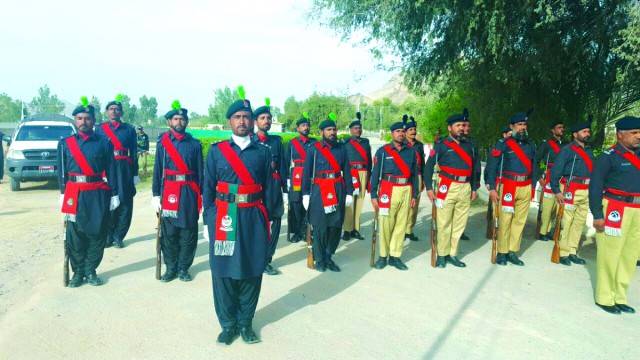
Over the last few weeks, the Balochistan government made the controversial decision of ending the jurisdiction of the Levies Force in the districts of Quetta, Lasbela and Gwadar. Levies still exist in these districts but are restricted to its stations and cannot perform law enforcement functions. This decision will affect local policing in these three districts of Balochistan.
Historically, the province has been divided into “A” and “B” areas for policing. Areas under category A include urban zones and these are under the jurisdiction of the police. B areas are made up of rural areas, which are under the jurisdiction of Balochistan Levies, a local force comprising the people from the same district where it is based. A areas only make up five percent of the province, whereas the B areas make up 95 percent of the province.
In 2003, President Musharraf merged Levies into the police. This is counted among the many blunders he committed in Balochistan. In 2010, the PPP government restored the Levies Force, a decision that was lauded by people across the province. Since taking power in 2018, Jam Kamal’s government has also sharpened its knives against Levies force. First, the government tried to hand over operational command of Levies to police in the three aforementioned districts. This did not work due to opposition from the Law Department.
Another lobby wants to merge Levies with police. This is not possible on legal grounds. In a 2013 judgment issued by Justice Amir Hani Muslim absorption has been declared unconstitutional by the Supreme Court. Hence, Levies cannot be merged with the police.
There is a perception that the Levies Force is under the control of tribal chiefs of the province. Back in the days of the British Raj, this was true to an extent but not anymore. Now, the Levies are under the command and control of the deputy commissioner (DC) of the districts. The DCs come from both provincial and federal service and they have full control of Levies. These officers in turn report to the provincial government which is the ultimate authority for Levies and not the sardars, as incorrectly claimed by the opponents of Levies.
There are three main factors that make the Levies a necessity for the policing paradigm of Balochistan. First, the Levies Force is the only functioning government department that exists in all the districts of Balochistan. Whenever there is a crisis or a natural disaster, it is the Levies which is used across the province to provide immediate relief. This is the only force that the district administrators have across the province to enforce law and order and run business of the government. Police, on the other hand, is only used for controlling crimes and cannot do all tasks that Levies perform. This means that without Levies the government machinery in districts of Balochistan outside the capital will collapse.
Second, the Levies are better than the police at maintaining law and order and controlling crimes because of their indigenous nature. Levies personnel in a district or even in a sub-district belong to the same area. They know the place and the people and can trace and deal with sources of trouble in the area. Secondly, given their roots in the same district, Levies personnel don’t take bribes and manipulate FIRs, which police allegedly do in the urban centers. Levies personnel can be found manning posts at deserted places, a range which police do not have.
Moreover, the crime rate in the Levies-manned area has historically been less than that of areas under the police. This is despite the fact that the police force as a whole gets more resources compared to the Levies for doing their job. This efficiency of the Levies Force is an asset for the governance system of Balochistan. However, the government wants to get rid of this asset, which is baffling.

Third, Levies has been criticized in the past for not being able to deal with the insurgency in Balochistan. This is an unfair criticism because Levies is not a counter-insurgency force. Its primary job is to carry out policing and enforce the writ of the state. There are other forces both civil and military which deal with terrorism and counter-insurgency. In the last few years, Levies personnel have received training from the army, which has made them better equipped to deal with the threats posed by the anti-social elements all over Balochistan. This means that criticism on the training levels of the Levies force does not hold ground anymore.
Lastly, Musharraf’s regime has gone down in history as a government that tried to merge Levies into police but the attempt failed. Now, the Jam Kamal-led government is once again on the same track and carrying out various maneuvers to gradually get rid of the Levies, which is an asset for the province. If the government succeeds in these efforts, then it will be a huge disservice to the people of Balochistan. In such a scenario, this government will go down in history as one which got rid of an efficient local force in Balochistan.
The writer is a journalist and researcher. He can be reached on Twitter @iAdnanAamir
Historically, the province has been divided into “A” and “B” areas for policing. Areas under category A include urban zones and these are under the jurisdiction of the police. B areas are made up of rural areas, which are under the jurisdiction of Balochistan Levies, a local force comprising the people from the same district where it is based. A areas only make up five percent of the province, whereas the B areas make up 95 percent of the province.
In 2003, President Musharraf merged Levies into the police. This is counted among the many blunders he committed in Balochistan. In 2010, the PPP government restored the Levies Force, a decision that was lauded by people across the province. Since taking power in 2018, Jam Kamal’s government has also sharpened its knives against Levies force. First, the government tried to hand over operational command of Levies to police in the three aforementioned districts. This did not work due to opposition from the Law Department.
Another lobby wants to merge Levies with police. This is not possible on legal grounds. In a 2013 judgment issued by Justice Amir Hani Muslim absorption has been declared unconstitutional by the Supreme Court. Hence, Levies cannot be merged with the police.
The Levies Force is the only functioning government department that exists in all districts of Balochistan
There is a perception that the Levies Force is under the control of tribal chiefs of the province. Back in the days of the British Raj, this was true to an extent but not anymore. Now, the Levies are under the command and control of the deputy commissioner (DC) of the districts. The DCs come from both provincial and federal service and they have full control of Levies. These officers in turn report to the provincial government which is the ultimate authority for Levies and not the sardars, as incorrectly claimed by the opponents of Levies.
There are three main factors that make the Levies a necessity for the policing paradigm of Balochistan. First, the Levies Force is the only functioning government department that exists in all the districts of Balochistan. Whenever there is a crisis or a natural disaster, it is the Levies which is used across the province to provide immediate relief. This is the only force that the district administrators have across the province to enforce law and order and run business of the government. Police, on the other hand, is only used for controlling crimes and cannot do all tasks that Levies perform. This means that without Levies the government machinery in districts of Balochistan outside the capital will collapse.
Second, the Levies are better than the police at maintaining law and order and controlling crimes because of their indigenous nature. Levies personnel in a district or even in a sub-district belong to the same area. They know the place and the people and can trace and deal with sources of trouble in the area. Secondly, given their roots in the same district, Levies personnel don’t take bribes and manipulate FIRs, which police allegedly do in the urban centers. Levies personnel can be found manning posts at deserted places, a range which police do not have.
Moreover, the crime rate in the Levies-manned area has historically been less than that of areas under the police. This is despite the fact that the police force as a whole gets more resources compared to the Levies for doing their job. This efficiency of the Levies Force is an asset for the governance system of Balochistan. However, the government wants to get rid of this asset, which is baffling.

Third, Levies has been criticized in the past for not being able to deal with the insurgency in Balochistan. This is an unfair criticism because Levies is not a counter-insurgency force. Its primary job is to carry out policing and enforce the writ of the state. There are other forces both civil and military which deal with terrorism and counter-insurgency. In the last few years, Levies personnel have received training from the army, which has made them better equipped to deal with the threats posed by the anti-social elements all over Balochistan. This means that criticism on the training levels of the Levies force does not hold ground anymore.
Lastly, Musharraf’s regime has gone down in history as a government that tried to merge Levies into police but the attempt failed. Now, the Jam Kamal-led government is once again on the same track and carrying out various maneuvers to gradually get rid of the Levies, which is an asset for the province. If the government succeeds in these efforts, then it will be a huge disservice to the people of Balochistan. In such a scenario, this government will go down in history as one which got rid of an efficient local force in Balochistan.
The writer is a journalist and researcher. He can be reached on Twitter @iAdnanAamir

